#worcester factory
Text
#WorldCamelDay: if your camel turns this color, please see a vet 😬
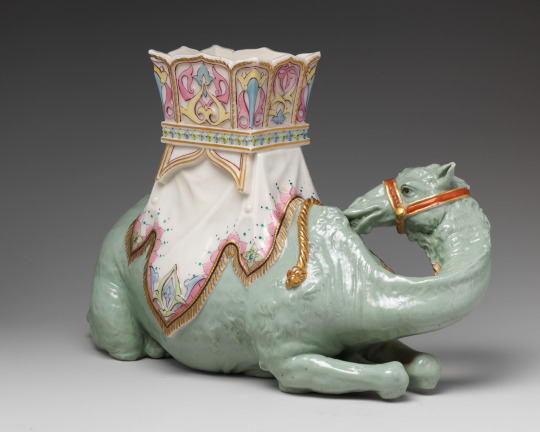
Vase in the Form of a Camel, 1870
Modeler: James Hadley (British, 19th century)
Maker: Worcester Factory (British)
Porcelain, 6 13/16 × 10 1/4 × 5 in. (17.3 × 26 × 12.7 cm)
The Metropolitan Museum of Art, New York
#camel#World Camel Day#porcelain#ceramics#decorative arts#James Hadley#Worcester Factory#vase#Metropolitan Museum of Art New York#animal holiday#animals in art#British art#European art#19th century art
55 notes
·
View notes
Photo
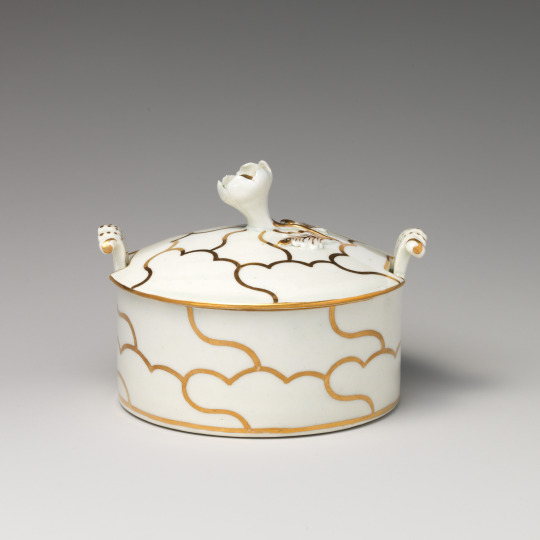
Butter dish with cover (part of a service), Worcester factory
Soft-paste porcelain, ca. 1775
Metropolitan Museum of Art
22 notes
·
View notes
Photo


Artist/maker: James Hadley (modelled)
Made by: Royal Worcester Porcelain Factory (designed 1881, made 1884)
“The teapot is a satire on what was seen at the time as the ‘affectation’ of the Art for Art’s Sake movement; the self-styled ‘sensible’ and ‘manly’ world of the Victorian mainstream press saw Aesthetes as effete poseurs. Both the male and female depicted by the Royal Worcester teapot are dressed in stereotypical Aesthetic clothing, reflecting the popularity of what Gilbert and Sullivan satirised as the “greenery-yallery” colours (such as sage green and mustard yellow) that were so popular amongst Aesthetes, and the lily and sunflower so delicately modelled here were the two iconic floral symbols of the Aesthetic ‘craze’ of the late 1870s and early 1880s. However, the teapot does not only refer to the Aesthetic craze of the time. Underneath is an inscription which reads: “Fearful consequences through the laws of Natural Selection and Evolution of Living up to one’s Teapot”. This inscription was a satirical comment both on Oscar Wilde’s tongue-in-cheek quip about his blue and white china, and also on the hysterical fears circulating in the 1880s about the effects that effeminacy and the blurring of gender roles might have on the future British population.” - Dr. Sally-Anne Huxtable, Principal Curator, Modern and Contemporary Design, National Museum Scotland
#aesthetes#oscar wilde#aesthetic art movement#gilbert and sullivan#teapot#art history#victorian era#gender roles#effeminate#gender#royal worcester porcelain factory#porcelain#antique porcelain
18 notes
·
View notes
Text
The Advantages of Bedroom Furniture
Every home can benefit from having high-quality, solid wood furniture. These items are timeless, adaptable, and incredibly well-liked. Solid wood furniture from furniture stores in Rhode Island is mostly considered by interior design for every area in the house, from bedrooms to living rooms to dining rooms and beyond. Unfortunately, a lot of people opt for furniture constructed of inferior materials. These can be made quickly and at a lower cost, but they don't have the size, grandeur, longevity, or tradition of solid wood furniture.
Strong, durable construction
One of the strongest, most resilient, and longest-lasting materials is wood. Cheaper materials, like MDF, are easily damaged and over time start to chip. They are fragile and flinch under pressure. They may start to squeak with use over time.
Undeniable beauty
Solid wood, like oak or pine, from a furniture factory outlet has a distinctive appearance, feel, and air of dignity and allure. No two pieces of solid wood are the same, from lighter shades to rich, dark tones.
Creative flexibility
Some materials are only appropriate for certain items, spaces, or themes. None of these restrictions apply to wood. It is a material that blends well in almost every environment, from more contemporary design choices to more rustic, traditional ones.
Similar to how multiple finishes and wood species can be intimately combined, achieving a visual harmony that a material like plastic can never achieve. A lighter wood, like oak, can be combined with the deeper tones of solid pine stained in a finish like Old Wood to create a variety and versatility in interior design.
#bedroom furniture worcester#furniture factory outlet massachusetts#furniture providence#mattresses ri#furniture stores in worcester#living room furniture ma#furniture places in massachusetts#furniture ri#mattresses ma#best furniture stores in ma
0 notes
Text
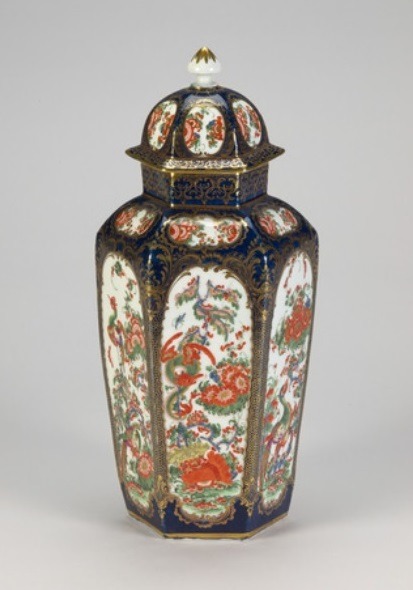
Covered jar, by the Worcester Porcelain Factory, 1765.
20 notes
·
View notes
Text

Moon flask by Worcester Factory, 1880s. The MET.
6 notes
·
View notes
Photo

Tea Service. Manufactured by Worcester Porcelain Factory in England, ca. 1877-1878. Bone china, enamel and gilding.
(Source: artic.edu)
#tea service#tableware#1870s#worchester porcelain factory#british design#japonisme#decorative arts#ceramics#bone china#gilding#cc0#blue#white
269 notes
·
View notes
Text

Teapot, porcelain, painted and gilded, with wriggling ground pattern is known as vermiculation.
Barr, Flight and Barr Factory, England (Worcester), 1807-13.
Victoria & Albert Museum.
9 notes
·
View notes
Text
CASES TOO DISTURBING TO READ TWICE: THE MONSTER OF WORCESTER
In 1973, the United Kingdom would experience one of the most brutal murders in their history. The crime was so brutal that the man responsible for it wasn’t even known by his actual name. He was known as “The Monster of Worcester.” This man committed a triple homicide of three innocent children and is walking free today.

WHO WAS DAVID MCGREAVY?
David McGreavy was born in 1951 and raised in Southport Lancashire. His parents, Thomas and Bella McGreavy, had five additional children. The McGreavy family moved around quite often due to Thomas being in the military, and David wanted to follow in his fathers footsteps. David left school in 1967 and joined the Royal Navy and hoped to make this his official career. However, he was court martialed in 1971 due to causing a fire which burned down a mess wardroom. With nowhere else to go he moved back in with his parents and was fired from multiple jobs since moving back home. He also had a fiance who left him during this time, and everything negative piling up in his life caused David to become depressed and began drinking heavily. In 1972 his parents started to grow tired of his drinking and lack of motivation to look for work and were kicked out of their home.
DAVID JOINED THE RALPH’S FAMILY HOUSEHOLD
Needing a new place to live he asked his friend Clive Ralph if he could board in his home with his wife Elsie and their two children, Paul, 4, and Dawn, 2. The Ralph family welcomed him with open arms, and began paying them six euros a week after he started working at a factory. At the time he moved in Elsie was also pregnant with their third child, who would be named Samantha. Clive and Elsie met when they were young, and had a five year age gap between them. The two married in 1968 when Elsie was 16 and pregnant with Paul, and the family lived on Gillam Street in Rainbow Hill district of Worcester. Samantha was born in September 1972.
On top of paying weekly rent, David would also cook Sunday dinners on occasion, and even became a babysitter when Elsie decided to go back to work when Samantha turned 7 months old. Clived worked as a lorry driver with his father, and Elsie found a job as a barmaid at the Punch Bowl Tavern. David was known by family, friends, and even neighbors to love children, and especially loved the Ralph children. They got along super well, he played with them often and he was basically like a second father figure to them. Which is why everyone was so utterly baffled when the tragedy occured.
On Friday, April 13th, 1973, Clive left the children home alone as they slept to go pick up David at the Buck’s Hill Pub so he could bring him home to babysit the children while he went to pick up Elsie who was working late. David was at the pub for a while with a friend as they played cards and darts, and drank around 5 to 7 imperial pints (2.8 to 4.0) of beer. David was known to become very angry and violent whenever he drank too much, and even got into some kind of altercation at the pub before leaving. Clive brought him back home and went to grab a drink with Elsie before coming back home. Clive didn’t know what kind of horror he was about to return to.

DAVID’S DRUNKEN RAGE
Sometime between 10:15 PM and 11:15 PM David became extremely frustrated with the children. It all started when baby Samantha, who was 9 months old at the time, started crying constantly for her bottle. David snapped and began to kill the children violently, all in different ways. He started with Samantha who died of a skull fracture. He then went to Dawn and slit her throat, and strangled Paul. After they were all dead, he made his way downstairs to the basement where he retrieved a pickaxe so he could further mutilate their bodies. To conclude this horrific scene, he brought all three children outside and impaled their bodies onto the spikes of a wrought iron fence in the neighbors yard, and then left the home. By the time the Ralph’s got back home the police were already there. They couldn’t allow them to go into the home or the yard due to how horrific the scene was, and escorted them down to the station where they were told about the deaths of their children. David was arrested around 3:50 AM as he was walking along one of the streets near their home, and he originally asked why they were arresting him. Once he was at the station he denied ever having any responsibility towards the murders, but after a few hours he came clean.
“It was me, but it wasn’t me,” he told investigators, and began to describe what happened in detail.
“I put my hand over her (Samantha’s) mouth, and it all went from there. It’s all in the house. On Paul, I used a wire. I was going to bury him, but I couldn’t. I went outside and put them on the fence. All I could hear is kids, kids.”
The only reasoning he could give about why he committed the murders, is just that the baby wouldn’t stop crying.
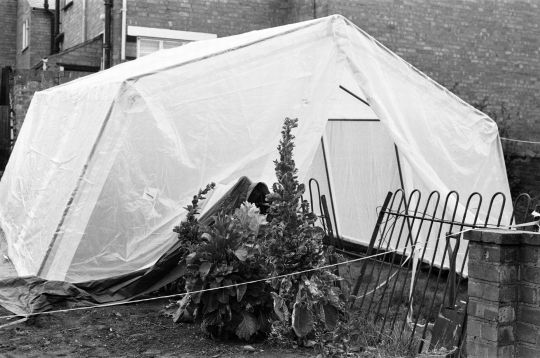
SENTENCING, LIFE IN PRISON, PAROLE
On June 28th, 1973, David McGreavy appeared in court and pleaded guilty to his crimes. He received multiple life sentences with the minimum of 20 years. Due to being subjected to frequent abuse by other inmates, David was held in a vulnerable prisoners unit for the majority of his 45 years in prison. While he was in prison it was reported that he had successfully adjusted to life in prison, accepted rehabilitation, and even took up painting as his main hobby.
When the crime first happened there was major press about the case. However, instead of being called David McGreavy, he was only known as “The Monster of Worcester.” Due to the lack of news since there was no trial, this case quickly dwindled from the press overtime and no one really talked about it much after that. That all changed in 2009, when a reporter took a photo of David as he was being transferred to an open prison. This caused him to be transferred back into the closed prison, and an anonymity order was issued by the high court of justice during his parole board hearing. The British Press Association argued that this order would prevent coverage of dangerous criminals possibly being released back into society, and David would be in lack of danger if and when he’s released. The order was lifted on May 21st, 2013. After the order was lifted the case started receiving a lot of publicity once again, after not hearing about it for over 40 years.
David McGreavy was paroled in December of 2018 due to “changing considerably.” He is now in his early 70s and is thought to have an electronic tag and living in supervised accommodation, and is banned from Worcester completely, along with the area where Elsie and her family live.

ELSIE RALPH
Elsie Ralph has since ended her marriage with Clive, moved away from the area, remarried and now goes by Elsie Urry or “Dorothy Urry.” She has, and never will, move on from this nightmare, as she states in an interview in June 2013.
“If he was released, I would be waiting outside with a gun. Life should mean life and he should never get to walk free. He got off lightly with a life sentence - he should have been hanged.”
“I think about what he did every minute of every day because he took my life away. He took my kids, my husband, and my home. I can’t go to family parties anymore, I can’t celebrate anything.”
“I can’t and will never move on. For what he did to my three children and me, he deserves the same treatment that they got - death.”
#true crime#true story#truecrime#true crime blog#Crime#murder#true crime community#Writerscommunity#writing#writers on tumblr#blog#blogging#blogger#blog post#blogpost
9 notes
·
View notes
Text
American Culture in the 1910s: Film Audiences and Exhibition Space
“At the start of the decade, most urban film-going Americans saw their films in nickelodeons. (Rural and small- town audiences formed an important market for films but were initially served by travelling shows in often makeshift venues.) Nickelodeons, which were usually small, poorly ventilated and cheaply run venues – often utilising old storefronts, with wooden benches for seating and a sheet of muslin for a projection screen – were then nearing the end of their extraordinary vogue, which had begun in 1905.
Estimates vary but, at their peak year of 1908, there were approximately eight thousand nickelodeons nationwide; in Indianapolis in 1908, for example, there were twenty-one, only three years after the city’s first one opened. For a nickel, one gained admission to a theatre playing a programme on continuous loop. Usually with only one (hand-cranked) projector, the nickelodeons covered the changing of reels – or merely mixed up the programme – with vaudeville acts, ‘illustrated songs’ (projected slides accompanied by a local singer who performed in- house) or illustrated lectures.
Westerns, melodrama and slapstick comedy were all popular, and ‘daily changes’ saw the programmes alter each day. The audiences were typically working class, were often immigrants and contained many children; on occasion nickelodeons even aggressively marketed their services as providing cheap, secure (and entertaining) childcare. As Roy Rosenzweig has noted, in 1912 in Worcester, Massachusetts, a labour report noted the average weekly leisure budget for local working-class families ran to twenty cents.
In such circumstances the cinema – cheaper than other cheap amusements such as vaudeville, ten-cent melodrama or even saloons – had a decisive advantage, even if one discounts the enthralling nature of the films to these early audiences. But enthralled they were, and not as passive consumers of escapist fantasies, as cultural elites often charged (Young American architectural critic Lewis Mumford, for example, damned the cinema as a form of ‘spiritual masturbation’ which gave ‘jaded and throttled people the sensations of living without the direct experience of life’.)
Instead, as Steven Ross notes, ‘life inside these theaters was filled with talking, yelling, fighting, singing, and lots of laughter. Movie theaters were places where people could recapture the sense of aliveness that had been lost in the regimented factories of the era.’ The cinema was often referred to at this time as the ‘workingman’s academy’, and a survey of cinema audiences in Manhattan in 1910 found that 72 percent came from the blue-collar sector, 25 percent from the clerical workforce, and 3 percent from what the surveyors named the ‘leisure class’.
Exactly when, and how, the middle class was enticed into film-going is a matter of debate among film historians but this was one of the decisive shifts of the decade, and one which the far-sighted in the film industry assiduously encouraged. As with many forms of working-class recreation in the era, such as dancing and the saloon, nickelodeons attracted the attention of Progressive reformers and morality campaigners.
They consistently critiqued their poorly lit, poorly ventilated halls, where ‘darkness afforded a cover for familiarity and sometimes even for immorality’, in the words of one report in Chicago. (Indeed, such concerns led to the widespread instigation of low-level lighting, rather than screenings in complete darkness.) Reformers worried about the sheer imaginative and ideological power of the cinema, how it was ‘literally making the minds of our urban populations today’, and functioning as ‘a place where people learn how to think, act, and feel’.
They praised ‘educational’ fare, such as the popular ‘travel films’ of the early decade, but agonised over other aspects of this new entertainment; these included the risks of white slavery to unescorted girls, the moral and socialising impact of films on an audience disproportionately composed of children, and the potential for copycat crime in films glamorising robbery, abduction and violence. More practically, reformers pointed out the very real risks of fi re, especially in an era of flammable nitrate film stock.
‘Vulgar’ vaudeville shows, foreign (and especially French) films or films with strong working- class political sympathies were also regularly targeted, and this often dovetailed with industry attempts to ‘clean up’ the movies to attract the ‘better classes’. Voluntary self- censorship, as would be the case for much of the life of Hollywood, was seen as the answer to the issue of the moral and political governance of film content, and to this end the National Board of Censorship was instituted in 1909.
Increasingly, and tied in with the move to feature- length productions, film- makers drew upon stories with the cultural cachet to attract the middle class; biblical and classical narratives were popular, as were adaptations of classic plays and novels, often featuring big-name stars from the ‘legitimate’ theatre. This was in contrast to early genres of film, such as chase movies, slapstick and fight films, which borrowed from the more ‘morally dubious’ styles of vaudeville.
Another factor enticing the middle class to the cinema was the development of converted high-class theatrical venues and purpose- built cinemas. With more seats and luxury than the typical nickelodeon, these began to occupy a larger percentage of the nation’s seating capacity in the decade. The nation’s film trade press lavished attention on spectacular ventures such as Samuel L. ‘Roxy’ Rothapfel’s Strand Theatre – the first purpose- built cinema on Broadway, which opened to its 3,500 capacity in April 1914 – even though such venues initially served only a fraction of the national film audience. (The average capacity in 1916 was 502 seats.)
A sensation, the Strand’s decorative opulence attracted forty thousand patrons in its first week, all of whom paid more than five cents (a box seat cost half a dollar). As Rothapfel later commented, he aimed to make his patron feel ‘that he is our special guest and that nothing for his comfort and convenience has been overlooked’, and that ‘a policy of dignity, honesty, and good taste’ governed his programming.
In May 1918 the weekly programme at the Strand included a live orchestral rendition of Franz Suppe’s ‘Light Cavalry’ Overture, a newsreel, an educational ‘scenic’ film, four popular songs, the Screen Classics feature Toys of Fate, and the First National comedy ‘Here Comes the Groom’.
Nonetheless, as Richard Koszarski has pointed out, film viewing conditions in such venues were far from what contemporary audiences would expect: films were regularly butchered by exhibitors in these prestigious ‘first run’ houses to cut them to a length which fitted the overall programme, and projectionists would regularly speed up the projection through dull moments. Marcus Loew, one of the major forces in film exhibition of the era, summed up well the general disregard for the artefact of the film print: ‘We sell tickets to theaters, not movies.’”
- Mark Whalan, “Film and Vaudeville.” in American Culture in the 1910s
8 notes
·
View notes
Text
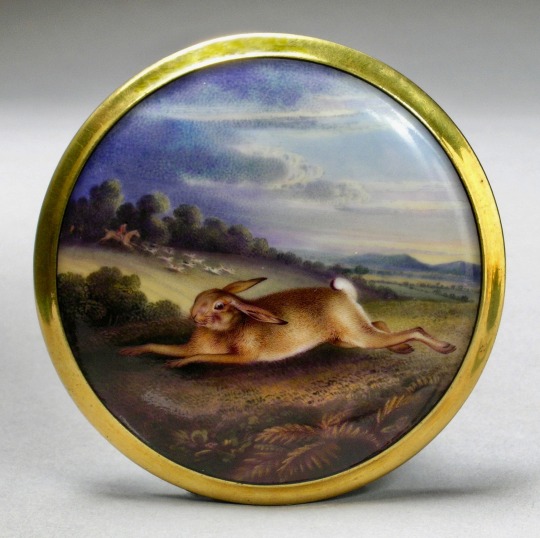
Snuff Box Lid: 'Hare Coursing'
Chamberlain's Factory (England, Worcester, 1788-1852)
Humphrey Chamberlain, Jr. (England, Worcester, 1791-1824)
England, circa 1820
Tools and Equipment; boxes
Porcelain, gilding, fabric
LACMA
11 notes
·
View notes
Text
20 Years of Tears Tour
Hawthorne Heights have announced a 20 years of tears tour. Thursday, Armor for Sleep, Saosin, Cartel, Anberlin (and some others) will be on select dates.
Tour Dates
June 22 Stateline, NV Lake Tahoe Is For Lovers *
June 23 Salt Lake City, UT Granary Live
June 24 Denver, CO Ogden Theatre
June 27 Milwaukee, WI Milwaukee Summerfest
June 28 Chicago, IL The Salt Shed
June 29 Grand Rapids, MI Intersection Outdoors
June 30 Cleveland Heights, OH Cain Park
July 1 Detroit, MI The Fillmore
July 3 Charleston, SC The Refinery
July 6 Clearwater, FL The BayCare Sound
July 7 Pompano Beach, FL Pompano Beach Amphitheater
July 9 Atlanta, GA The Eastern
July 10 Greenville, SC The Foundry
July 11 Asheville, NC Salvage Station
July 13 Charleston, WV West Virginia Is For Lovers *
July 14 Pittsburgh, PA Stage AE
July 16 Silver Spring, MD The Fillmore
July 17 Wallingford, CT The Dome at Oakdale
July 20 Manteo, NC OBX Is For Lovers *
July 21 Charlotte, NC The Fillmore
July 23 Knoxville, TN The Back Alley at Creekside
July 24 Nashville, TN Skydeck
July 25 Fort Wayne, IN The Clyde Theatre
July 27 Sauget, IL Pop’s Is For Lovers *
July 28 Rogers, AR The Walmart Amphitheater
August 3 Hot Springs, AR Magic Springs Theme Park
August 8 St. Augustine, FL The St. Augustine Amphitheatre
August 9 Orlando, FL House of Blues
August 10 Pensacola, FL The Handlebar Outdoors
August 12 New Orleans, LA The Fillmore
August 13 Katy, TX Home Run Dugout
August 14 Austin, TX Stubb’s Waller Creek Amphitheater
August 16 Kansas City, MO Uptown Theater
August 17 Eau Claire, WI Reverb Music Festival
August 18 Superior, WI Earth Rider Fest Grounds
August 19 Fargo, ND Outdoors at Fargo Brewing
August 21 Green Bay, WI Epic Event Center
August 22 Cedar Rapids, IA McGrath Amphitheatre
August 24 Council Bluffs, IA Iowa Is For Lovers *
August 26 Dallas, TX Toyota Music Factory
August 27 San Antonio, TX Sunken Garden Theater
August 28 Lubbock, TX Lonestar Events Center
August 31 Los Angeles, CA California Is For Lovers *
September 1 Phoenix, AZ The Van Buren
September 2 Albuquerque, NM Revel
September 5 Memphis, TN Minglewood Hall
September 7 Cincinnati, OH Ohio Is For Lovers *
September 8 Pickering, OH Pickering Casino Resort
September 10 Bangor, ME Cross Insurance Center
September 11 Sayreville, NJ Starland Ballroom
September 12 New York, NY Palladium Times Square
September 13 Harrisburg, PA XL Live Southside Stage
September 14 Wayland, NY FOrX Summer Stage
September 15 Worcester, MA The Palladium
Tour Dates by Band
June 23 to July 10
Hawthorne Heights/I See Stars/Anberlin
Armor For Sleep
Emery/This Wild Life
July 11
Hawthorne Heights/Anberlin
Armor For Sleep
Stick To Your Guns/This Wild Life
July 14, 17-28
Hawthorne Heights/Thursday/Anberlin
Armor For Sleep
Stick To Your Guns/This Wild Life
July 16
Hawthorne Heights/Anberlin
Armor For Sleep
Stick To Your Guns/This Wild Life
August 9-22
Hawthorne Heights/Thursday/Anberlin
Armor For Sleep
Emery/This Wild Life
August 26-28
Hawthorne Heights/Thursday/Anberlin
Cartel
Emery/This Wild Life
September 1-5
Hawthorne Heights/Saosin/Anberlin
Cartel
Stick To Your Guns/This Wild Life
September 10-15
Hawthorne Heights/Anberlin/Cartel
Stick To Your Guns
Emery/This Wild Life
---
Please consider becoming a member so we can keep bringing you stories like this one.
◎ https://chorus.fm/news/20-years-of-tears-tour/
0 notes
Text


Its true, its true! And the other thing is, my sister had a baby and I took it over after she passed away and the baby lost all its legs and arms and now its just a stump but I take care of it with my wife and... and its growing and its fairly happy... and its difficult because I'm working a second shift at the factory to put food on the table but all the love that I see in that little guy's face it makes it worth it in the end. True story.
Avaliable on my etsy store 😂🩷
#shrimp#shark tale#movie quotes#arts and crafts#crafts#funny#etsyseller#etsyshop#etsyfinds#handmade#gift ideas#gift#phone charm#phone accessories#keycharm#keychain#keyring#my sister had a baby#dreamworks animation#dreamworks#meme#funny memes#homemade#unique gifts
1 note
·
View note
Text
Advantages Of Purchasing a Good-Quality Mattress from A Reputable Furniture Store
Your complete health and well-being depend on getting a good night's sleep, which is made possible with the correct mattress. You're making an investment in your sleep quality and general quality of life when you decide to spend money on a high-grade mattress from a reputed furniture retailer. We'll explore the many advantages of getting a high-quality mattress from a reputable furniture retailer in this blog.
The primary benefit of a high-quality mattress is the substantial improvement in sleep. The ideal mattress from “factory furniture outdoors” provides the best alignment, support, and comfort, promoting pleasant sleep.
While you sleep, a high-quality mattress ensures optimal spinal alignment. This lessens back pain and lowers the possibility of musculoskeletal problems in the future.
The hallmark of a high-quality mattress is comfort. You'll have a snug and comfy sleeping surface every night if the support and cushioning are balanced properly.
When compared to less expensive options, a good-quality mattress often has a longer lifespan. This implies that you won't need a replacement for a long time after beginning to reap its benefits.
Numerous high-quality mattresses are built to withstand allergens like dust mites and mildew. For those who suffer from allergies or respiratory disorders, this is especially advantageous.
A high-quality mattress from mattress sales in MA is made to resist regular use and keep its contour over time. Your purchase will be pleasant and supportive for years because of this durability.
A high-quality mattress is designed to offer sufficient support in a range of sleeping positions. This makes sure that whether you sleep on your back, side, or stomach, you are well supported.
#furniture places in massachusetts#mattresses ri#furniture stores in worcester#furniture providence#furniture factory outlet massachusetts#bedroom furniture worcester#furniture ri#mattresses ma#best furniture stores in ma#living room furniture ma
0 notes
Text
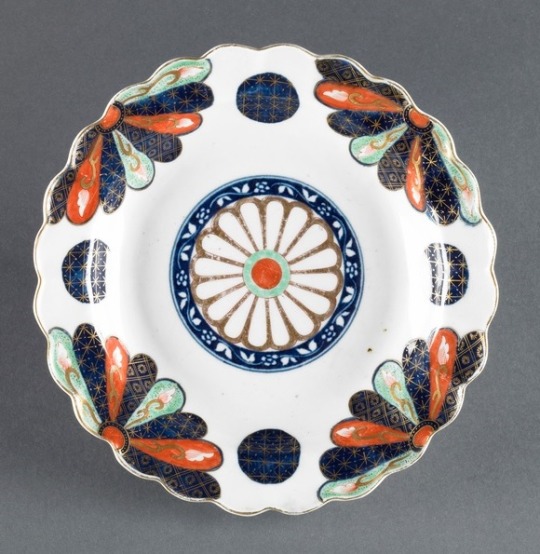
Plate by the Worcester Porcelain Factory, 1770, Worcester, England.
64 notes
·
View notes
